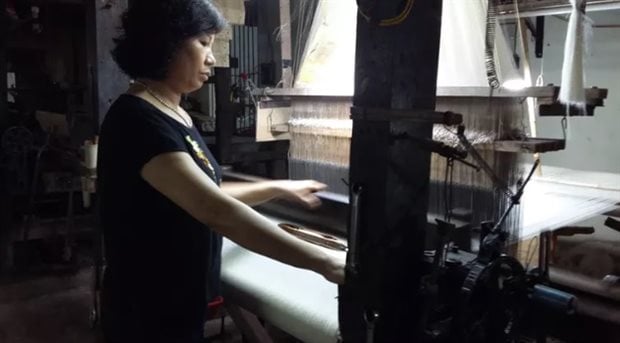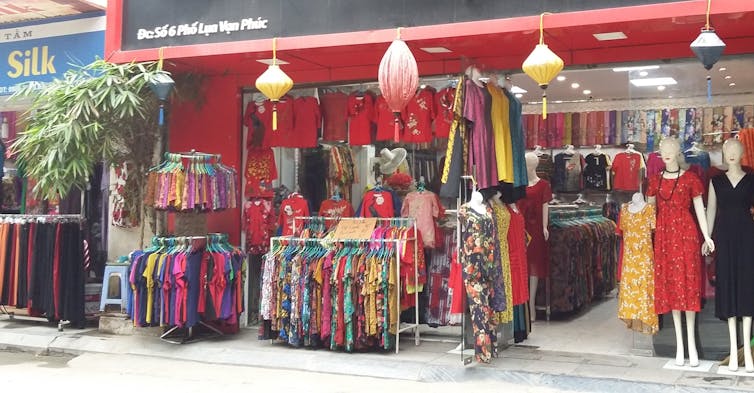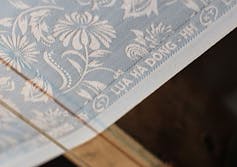'Made in Van Phuc': How place identity can help artisans survive in a globalised world

This approach isn’t the unique domain of just a few firms, of course – it can be extended to those that are currently less known and in more peripheral places. An eloquent example is the Vietnamese town of Van Phuc, in the Ha Dong (Hanoi) district, which has specialised in silk weaving since the 13th century. Establishing a strong place identity – how meanings attached to a locality can affect locals’ sense of self – was essential for their craftsmen to stand out from the crowd.
Ancient traditions, “new” competitors
Located approximately 10km from the centre of Hanoi, Van Phuc is considered the oldest and best-known silk-producing village in Vietnam. During our research team’s initial fieldwork, we found that in boutiques where Van Phuc silk products were sold, there were similar goods made in China. Based on the products’ variety and price, distinguishing between the two was relatively easy, and because of the craft methods used by Van Phuc’s artisans, their offerings are often much more expensive than similar ones from China.
In a report on Van Phuc made by the national television broadcaster of Vietnam, a storekeeper in the village stated:
“I sold a lot of Chinese silk products, compared to Van Phuc ones, because they are cheaper and there are a wide range of products.”An experienced silk weaving artisan added:
“Van Phuc’s silk patterns are not as diverse as Chinese ones because our products are made manually. Therefore our patterns are still very ‘naive’. There is something unmistakable.”According to a local shop owner and artisan, the price of natural silk is around 1,700,000 dong per kilogram (approximately 73 US dollars) while the price of a kilogram of polyester yarn is about 50,000 to 60,000 dong per kilogram (2 to 3 dollars).
Van Phuc’s products are not only made of natural silk, but they also have traditional patterns created during a sophisticated weaving process. By comparison, foreign-made goods have printed patterns and made by polyester or polyester silk fabrics. The savoir-faire of each creation has been improved for one generation to another, guaranteeing high quality.

Still, appreciating handmade craft items and being able to pay for them is not easy for all consumers. Despite its strong place identity and the quality and creativity of its products, Van Phuc is at risk of losing ground.
In the village, silk fabrics and other silk products are directly sold at home-based workshops of craftsmen or retail stores, among which some are owned by artisans. Nevertheless, due to urbanisation, more and more craftsmen do not have enough space for silk weaving tools to produce their own products. The traditional silk workshops are at risk of disappearing, to be replaced by imported products from China sold at retail outlets.

For the moment, Van Phuc silk products still have a stable customer base. They are often bought by foreign tourists who seek out unique Vietnamese products, or by Vietnamese who prefer to use high-quality domestic goods. Residents of Vietnam often go to Van Phuc workshops directly and choose the products they like instead of buying at eye-catching retail outlets in the village.
Place and identity
The story of craft products threatened by mass-produced goods is not a new one, and can appear everywhere. How to arrive at a long-term solution is the real question. In the case of Hermès, its identity is tightly linked to a place – it is not just “Hermès”, but “Hermès Paris”. Here, the associated “memories, ideas, feelings, attitudes, values, preferences, meanings, and conceptions of behaviour and experience” play a huge role. Indeed, the feeling of belonging to Paris, and French elegance in general, is a significant part of what attract clients to the goods.

While place branding cannot be carried out for every geographic locality – there’s only one Paris in the world, after all – Van Phuc’s artisans have recently perceived the importance of place identity, and on their products now feature the words “Van Phuc silk” or “Ha Dong silk”. This allows local artisans to distinguish themselves, affirm the high quality of Van Phuc’s traditional silk products, and gain or regain the confidence of Vietnamese consumers. This initial step also allows producers to “shine a light” on local products among numerous foreign ones, in particular after one of the biggest silk brands in Vietnam was found to be selling “silk” products with no silk at all.
In the long term, if Van Phuc’s reputation can be expanded to a wider geographic scale – not just domestically but also internationally – their products will surely have a place (identity) in the market.
